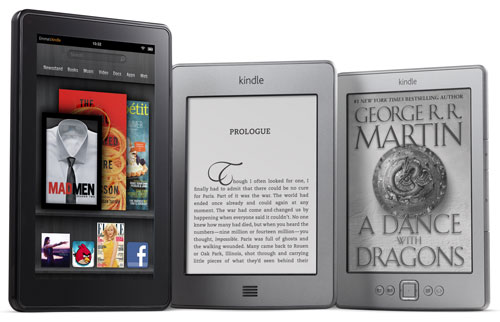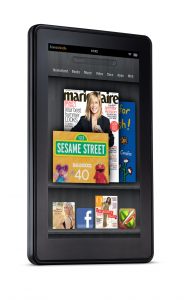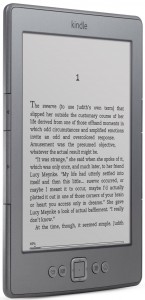
With the announcement of the Kindle Fire on Wednesday, Amazon.com hasn’t just entered the tablet market aggressively: it may be about to change it fundamentally. The product is groundbreaking because it deftly addresses the two most pressing issues for consumers, price and content.
On Wednesday, Amazon announced four new Kindles, the most expensive of which, the Fire — which isn’t really a Kindle at all, at least not in the traditional sense — will retail for US$199. The Fire isn’t an e-reader, it’s a tablet, and it’s by far the most exciting of four new Kindle products Amazon unveiled on Wednesday because it offers most things most people want from a tablet, but at less than half the price of Apple’s iPad 2.
Evolution not revolution
The first three of the new Kindles announced on Wednesday are e-readers in the style of early incarnations of the device, but now devoid of a Qwerty keyboard, and with the two pricier models sporting touch screens.
The two entry level Kindles, the $79 basic version its $99 touch-based sibling, are noteworthy mainly because of their aggressive prices. The Kindle is already the iPad of the e-reader market. Now, with two models under $100, it’s only noteworthy competitor — Barnes & Nobles’s Nook — looks overpriced. The Nook costs $139 for an entry-level model and $249 for the flagship version.
Then there’s the Kindle 3G Touch. At $149, it costs $10 more than the basic Nook, but offers Amazon accountholders in the US free 3G connectivity in 100 countries — no subscription or Sim card required. Clearly, Amazon hopes to recover these costs through the sale of books and other content.
Though this means little to the rest of the world, which won’t be seeing the benefits of Amazon’s new Kindles until the company can figure out how to roll them out in other regions while offering the same functionality, the shift in how its competitors are going to have to think about value-added services and providing content to users is enormous.

All fired up
The Kindle Fire looks set to be the first tablet that really puts pressure on Apple’s iconic iPad, despite offering only a 7-inch display, lacking a 3G option and being devoid of cameras and microphone. But at just $199 versus the entry-level iPad 2’s $499 price sticker, Amazon could entice millions of people who have not already bought a tablet computer.
Amazon started life selling physical books in 1995, before expanding into consumer electronics and other products. It’s now the biggest online retailer in the world, selling everything from computers to toilet paper.
But the company doesn’t sell only physical goods. It also sells digital music, e-books and offers movie and television show rentals.
With the Fire, Amazon can now connect that digital marketplace with a compelling media consumption device. As Apple has proved, if content can be accessed conveniently, people will pay for it — and they won’t even mind being locked into a proprietary system to do it.
With the Kindle Fire, Amazon has modified Google’s Android operating system and elected to offer only its own, vetted version of an Android application store, betting that most people will rather know that every app offered to them works perfectly on their device. Though power users might be upset at this approach, and bemoan the lack of access to the traditional Android Market, there’s no reason to believe it won’t work.
Apple’s dominance comes as much from its hardware as from it does from its content offerings. The iTunes and App Stores are what make the hardware valuable. After all, without content the hardware is impotent. That’s why Android tablets aren’t performing as well as the iPad and why Amazon is the best contender for the title of official opposition.
You can get a great experience and functionality from a generic Android device. It’s just not as effortless and, for the layman, effortlessness is directly related to appeal.
Sleepless in Redmond
Though Apple will be watching Amazon with a wary eye, it’s Microsoft that arguably should be most concerned. Apple already has enormous market share and some of the most loyal customers on earth. Microsoft, on the other hand, is hoping Windows 8, which will be released only next year, will make Windows tablets the real alternative to the iPad. Now, however, it appears that Amazon may steal the title from Microsoft before the Redmond, Washington-based software giant has even entered the fray.

With the Fire, Amazon is betting that most people don’t make video calls or record movies on their tablets and that few type much more than one-liner e-mails or instant messages. Apple may continue to dominate the top of the market, but Amazon will be quite happy to command the rest.
Sure, some people value a larger screen and bigger on-screen keyboard, but most people use tablets to consume media and to browse the Internet. The Fire promises to be great for both. And, besides, Amazon is strongly rumoured to be planning a 10-inch tablet for early next year.
It’s no surprise that Amazon is bundling the Fire with a one-month subscription to Amazon Prime, which allows users access to Amazon’s enormous catalogue of movies and series, and three months of access to 17 Condé Naste magazines. The future is content — and specifically the all-you-can-eat-for-a-fixed-monthly-fee variety.
Amazon is also punting what it calls Silk, the Fire’s Web browser that leverages the “raw computational horsepower of Amazon EC2”, its cloud computing service, combined with cloud storage and back-up for all purchased media – a necessity as the Fire only offers 8GB of internal storage.
It’s not just Amazon’s power as a retailer and its enormous digital inventory that make it a formidable opponent to Apple. It’s also the fact that it also understands the crucial role cloud computing is going to play in delivering content to users and creating a seamless multi-device experience.
Can we play, too?
From an SA perspective, the problem with the Fire is its dependence on Wi-Fi, and although that may not be a problem in the US where Wi-Fi is much more ubiquitous, it is an issue elsewhere.
Amazon has said it won’t offer the Fire or the two Kindle Touch models in Europe anytime soon, citing problems with regulators and telecommunications companies there, so it’s unlikely SA will see them any time soon, either.
Regardless, Amazon is betting that if users can get online and buy content anytime and anywhere, they will. If Amazon’s right, that sort of arrangement may become a reality worldwide sooner rather than later.
There’s little doubt that price alone will make the Kindle Fire a hot seller. Add Amazon’s content offerings to the equation and the device may prove to be an almost irresistible prospect for consumers.
Of course, it would be naive to think that Apple is suddenly going to be overtaken in the tablet market. It created it, and it’s going to continue to dominate it. But it would be equally unwise of Apple to underestimate the role that price plays in decision making by consumers.
Apple created the tablet market, but on Wednesday Amazon upped the ante in a big way. — Craig Wilson, Techcentral
- Subscribe to our free daily newsletter
- Follow us on Twitter or on Facebook
- Visit our sister website, SportsCentral (still in beta)




